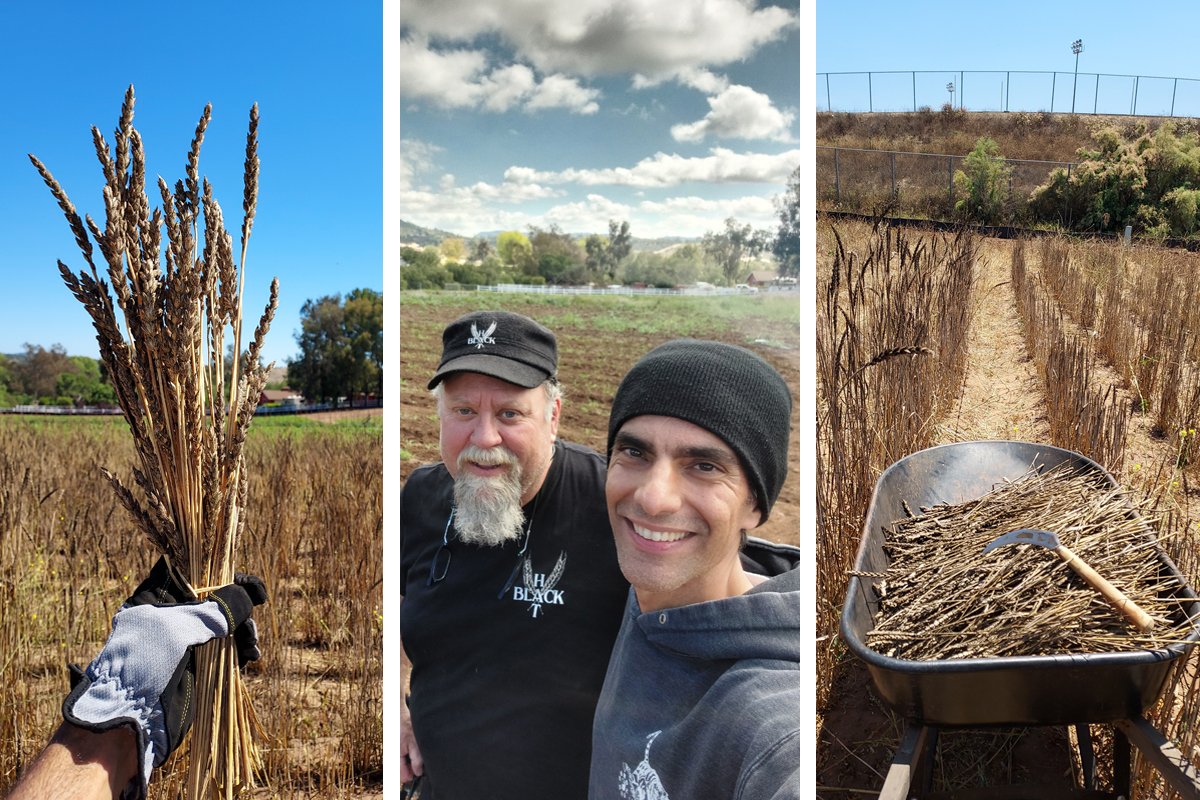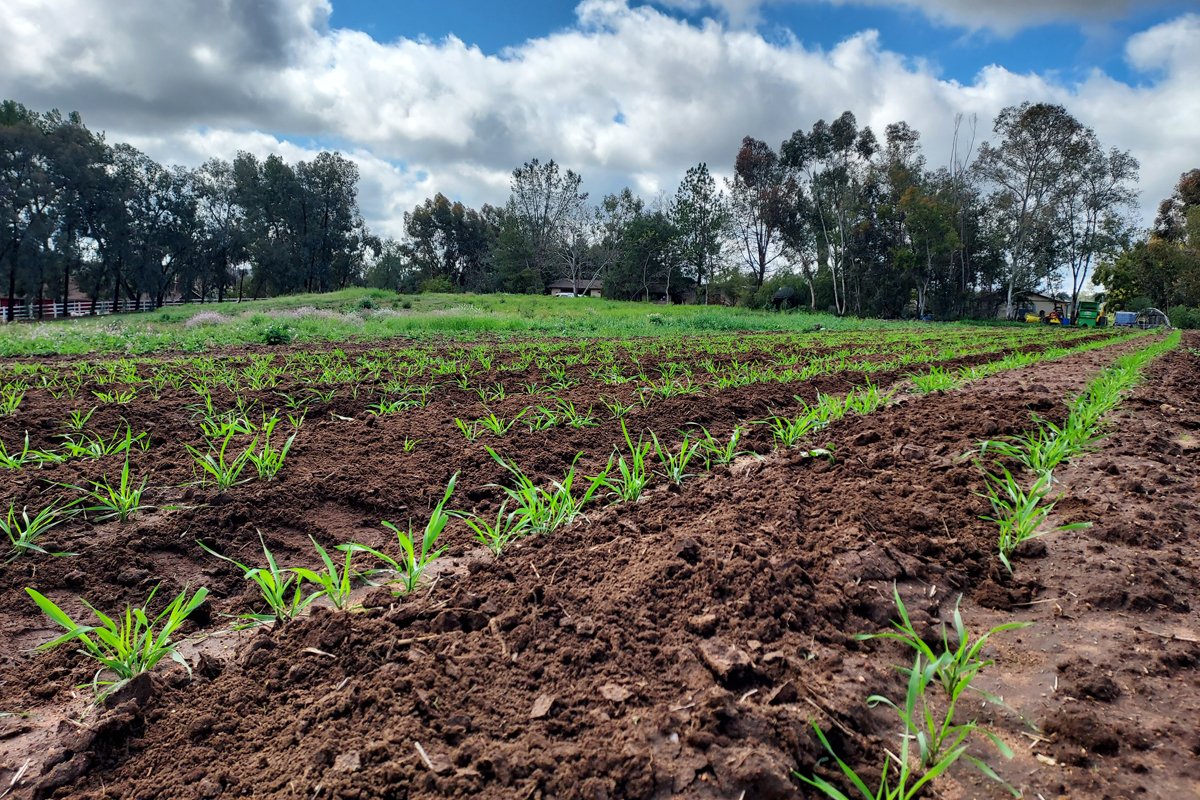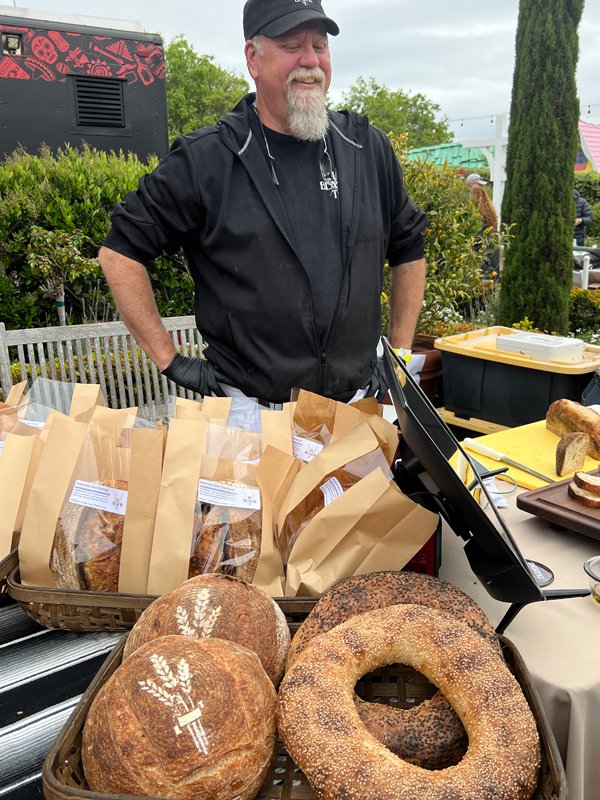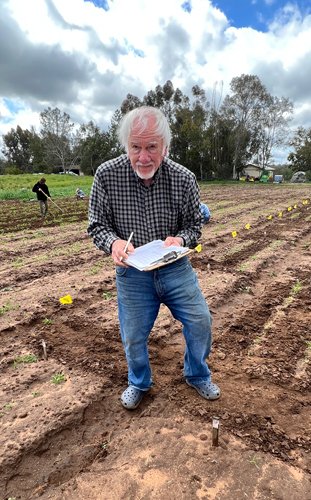Though San Diego is home to the greatest number of small farms of any U.S. county, wheat isn’t on the menu. Two artisan bakers are working to change that.

Though San Diego is home to the greatest number of small farms of any U.S. county, wheat isn’t on the menu. Two artisan bakers are working to change that.
November 14, 2023

Terry Ellis (left) and Noris Velazquez pictured at Rio Del Rey Farm in Valley Center, where they are experimenting with dry-farming wheat. (Photo credit: Noris Velazquez)
From 9 to 5, Terry Ellis works as an engineer for defense contractor Northrop-Grumman in San Diego. At night, and on weekends, he’s a serious sourdough bread baker—and an aspiring grain farmer.
After looking in vain for an affordable local wheat source, Ellis decided to experiment with dry-farming the grain himself on a small piece of land 45 miles north of San Diego, in rural Valley Center.
Waving fields of wheat once stippled the sunny lands of San Diego County, but higher-value crops supplanted it more than a century ago.
On a sparkling spring day in March, Ellis and a crew of volunteers gathered at Rio Del Rey Farm to pull weeds from rows of experimental dry-farmed wheat crops. The months prior had seen a series of atmospheric rivers that brought abundant rain to the region and the six-week-old heirloom wheat was sprouting—to the delight of all involved. Wielding a hula hoe, inch deep in healthy mud, Ellis admitted he hasn’t done much manual labor.
But he’s willing to pour some sweat equity into this experiment. Currently, his best whole wheat source is 350 miles north, in California’s San Joaquin Valley, and shipping costs have recently tripled. As Ellis uprooted weeds alongside fellow baker and martial arts instructor Noris Velazquez, the “Kung Fu Baker,” they commiserated over their supply woes.
Velazquez committed to the project because he wants his customers to have bread baked with local ingredients, grown sustainably, without Roundup weed killer. He’d like to tell them the wheat comes from heritage varieties, with essential nutrients absorbed from the soil. He’s been collecting seeds for years.
“I seek out purity of ingredients, those that speak to my heart, and that is why for the last 10 years I’ve been collecting heirloom wheat seeds—to one day plant and watch them grow, to learn from them, and pass on their radiant life force through a loaf of bread, from the heart,” Velazquez said.
Waving fields of wheat once stippled the sunny lands of San Diego County, but higher-value crops supplanted it more than a century ago. Though San Diego is home to more small farms than any county in the U.S., grain is not a profitable use of the region’s extremely expensive land and water. However, given recent declines in profitability of higher-value crops such as citrus and avocado—and growing demand for local, nutritionally dense ingredients and the resurgence of dry farming in California—conditions might be ripe for the return of a local grain economy in San Diego.
Twenty-five landrace and heritage varieties went into the ground at Rio Del Rey Farm in late January, with guidance from Heritage Grain Trials and consultation from Monica Spiller of Whole Grain Connection, a Silicon Valley-based nonprofit that connects farmers, millers, and bakers interested in building local grain economies. Landrace grains are pre-hybridized varieties that adapted to their local environments as they evolved, optimizing water use, energy, and nutrients. San Diego doesn’t have a native landrace wheat, so it’s up to growers to find what works based on historical wheat crops in the area and experimentation with heritage varieties. Slow Food USA is supporting this experiment and a second crop in 2024 with a $4,000 grant.

Rows of India-Jammu wheat planted at Rio Del Rey Farm yielded 60 pounds, or enough for 7 pounds of flour. (Photo credit: Noris Velazquez)
The small-scale experiment also reflects the larger efforts of multiple organizations around the country working to revive heritage grains, including Golden State Grains in California; Tehachapi Heritage Grain Project in California’s southern Sierra Nevada; Palouse Heritage Grains in Washington; and Native Seeds in Arizona. The collective goal is to revive plant diversity, raise crops sustainably in conditions made more challenging by climate change, and collect successful varieties for future crop resiliency.
The day after planting brought a stroke of good weather luck: several hours of gentle showers to water the seeds. A few days later, Valley Center bean farmer Mike Reeske, who donated half an acre of his small farm for this crop, was already betting on which seeds would be the winners in the slow and steady race to find a heritage wheat that will grow—with rainwater only—in San Diego County.
His top picks: White Sonora, brought to northern Mexico by Europeans in the 1600s or earlier, and grown throughout San Diego and the Southwest before modern irrigation; and India-Jammu, which the University of California Regional Testing Program recommends for rain-fed sites and is touted for its “desirable whole wheat artisan bread-making properties.”
Artisan sourdough bakers like Ellis and Velazquez seek flour that is more nutritious and heartier than the refined stuff from most wheat and commercial mills. Most modern wheat is a high-yielding semi-dwarf variety that does not produce roots as deep as many heritage types. “Landrace and heritage varieties of grains . . . invest in deeper root development and have greater mycorrhizal associations, which afford them vastly greater capacity to scavenge nutrients in low fertility soils,” Reeske wrote in the grant proposal.
Those nutrients are passed to consumers when wheat is milled the “old-fashioned” way: on a stone mill, which breaks up the wheat berries while grinding the nutritious bran and germ into the flour. But most wheat is processed on roller mills that remove the bran and germ to produce a fine white flour, while much of the product marketed as “whole wheat” is actually refined white flour with larger particles mixed back in. Ellis and Velazquez both aim for that nutrient-dense, chewy, bubbly, filling quality of artisan bread—which comes with stone-milled whole wheat flour. Velazquez buys heritage whole wheat berries from Palouse Heritage Grains.
A 2019 review of studies on the health benefits of heritage grains concluded that in clinical trials, “all doubts disappear and diets based on ancient or heritage cultivars always showed clear advantages in terms of anti-inflammatory and antioxidant activities.”
That might be welcome news for the seemingly growing number of people suffering from gluten allergies in the U.S.
“People who have gluten allergies tell me they can eat the sourdough I make from true whole wheat,” said Velazquez.
“The local wheat movement is a thing, but California is way behind,” said Claudia Carter, executive director of California Wheat Commission. Though California has the most commercial milling capacity of any state, it’s not equipped for small whole wheat batches. The state also lacks infrastructure to market heirloom wheat to buyers and specialty millers. That leaves it up to growers, millers, small-batch bakers, and heritage grain groups to build communities based on locally grown heritage grain.
Whole Grain Connection maintains a list of stone mills throughout the U.S. and connects collaborators to local grain economies. While there are several in the San Francisco Bay Area and Los Angeles vicinity, not one mill on the list is in San Diego. And the price of local flour is often considerably higher than conventional flour, making it a tough sell for many bakers.
“I would have thought it would develop faster in the California market, where people are willing to pay more for local foods,” Carter said.
California was the nation’s second largest supplier of wheat in the late 19th century. A staple crop at the state’s missions starting in the late 1700s, the grain proved adaptable to the Mediterranean climate. By the 1870s, farmers in San Diego County grew wheat on a large scale. “The prolific cereal grew with little effort,” said historian Walter Wormer. But intensive cultivation and lack of variety led to challenges in productivity.
By the 1880s, many San Diego farmers were opting to grow fruit trees on the county’s hilly topography. Increased access to irrigation and new transportation options to the East Coast made fruits, nuts, and vegetables more lucrative than low-priced grain. Wheat production in San Diego, and the rest of the state, declined dramatically by the early 1900s.
Wheat is still a tiny part of California’s economy: In 2021, it comprised 380,000 planted acres out of 27 million, or 1.4 percent, and it’s concentrated in the San Joaquin and Sacramento valleys and used mostly for animal forage. Desert Durum, a hybridized variety developed for pasta in the late 1970s, grows in the Imperial Valley, about 100 miles east of San Diego.
Dryland or “dry” farming means growing crops without added irrigation, using rain and residual soil moisture in areas that receive about 10 to 20 inches of rain per year. The method incorporates planting and tilling techniques that take advantage of terraforms and topography to position plants where water will flow, collect, and percolate through the soil to keep it moist during the growing season. Before modern irrigation, “dry-farming” was just “farming.” As the climate changes, it is becoming a resilience strategy to cope with less water. California farmers also dry-farm wine grapes, tomatoes, squash, and beans.
“Dryland wheat is likely to expand in California as scarcer water resources go to profitable crops.”
Some 120 to 130 years ago—when California was the nation’s breadbasket—most of the crop relied solely on rainfall. “Ten years ago, 80 percent of California wheat was irrigated,” said Carter. “Now some small-scale farmers are trying a dryland approach.”
Wheat is less water intensive than most of California’s other crops, making it well-suited to dry farming: It can be planted in winter, during the “rainy” season, and it’s one of the few crops that “will produce economically under dryland conditions,” wrote a USDA research soil scientist in Riverside back in 1970. Now, with limits on aquifer pumping imposed on growers by the Sustainable Groundwater Management Act (SGMA), dry-farming wheat may be a viable alternative to letting fields go fallow due to lack of water.
University of California, Davis, has multiple studies on dry-farming or reduced irrigation, including a project to breed drought-resilient wheat. Studies show that a hybrid model—adding just 4 to 8 inches of irrigation to supplement natural rainfall—could be the sweet spot for both wheat and water conservation.

Terry Ellis works as an engineer for defense contractor Northrop-Grumman during the day and bakes at night and on weekends. (Photo credit: Leorah Gavidor)
“Dryland wheat is likely to expand in California as scarcer water resources go to profitable crops,” said U.C. Davis agricultural economics professor Daniel Sumner. “It makes sense instead of leaving unused fields unplanted. In good rain years, it can yield a harvest; in dryer years, it can be used for forage.”
That’s already happening in San Diego, with successful results. Ernie Klemm, forage manager at Konyn Dairy in San Pasqual Valley, has been dry-farming grains for 50 years—as food for cattle. Klemm oversees unirrigated fields of triticale and beardless barley, which grew to be 5.5 feet high in this exceptionally rainy year. But Klemm says he sees a decent harvest even in dry years.
Lucky for Reeske and the bakers, this was not a dry year. By March, Valley Center had received 15 to 20 inches of rainfall, about 150 to 200 percent above normal. Dry-farming wheat in San Diego seems viable in a rainy year like this one, but it’s hard to forecast how the seeds would do in a drought.
North American grain production is mostly concentrated in the Great Plains, where infrastructure and way of life have supported the Grain Belt economy for over 100 years. It’s hard for smaller grain producers in other areas to compete. In San Diego, the focus for farmers for the past 100 to 125 years has been citrus and avocado, which don’t grow well in many other places.
In 2020, avocados occupied 14,500 acres, the largest share of planted acreage in San Diego County, and brought in almost $153 million. Total citrus sales were $146 million. Hay and oats, the only grains on the county’s crop report, brought in just about $500,000.

Valley Center bean farmer Mike Reeske donated a half-acre to the wheat-growing experiment. (Photo credit: Leorah Gavidor)
A 2020 University of California Cooperative Extension study on double-planting avocado trees (which San Diego growers do to maximize water efficiency) estimated $10,000 net profit per acre; net returns for wheat in the Sacramento Valley, at maximum yield and highest market price, were $117 per acre in 2016, when the price per bushel was about $4. Wheat prices set records recently due to the war in Ukraine, when bushel price hit a high of $11.02 in March 2022.
Also in 2022, San Diego avocados brought in less than $100 million for the first time in more than 25 years. Productivity of trees dropped nearly 50 percent due to drought, though prices rose. Water costs and availability are major considerations. In Valley Center, an acre-foot of water for ag purposes costs $1,900, compared to about $80 in Kansas, the nation’s top wheat-producing state. An acre of avocados needs about 4 acre-feet, or about 40 to 50 inches of rain; wheat needs 12 to 15 inches.
Water is only part of the equation. “In San Diego and Los Angeles, the biggest challenge to wheat production is land cost,” said Carter at the Wheat Commission. “Land cost has pushed out lower-value crops. Farmers ask themselves, ‘Why am I selling wheat for $4 a bushel when that was the same amount my grandpa was getting for it?’”
Agricultural land values for avocados in San Diego and Riverside counties ranged from $13,300 to $35,000 per acre in 2020, while the average is $4,610 in Kansas. Cost to rent farmland in San Diego is three times the national average. That makes lower-profit wheat a pretty hard sell.
Some San Diego citrus and avocado growers are transitioning to other less thirsty crops, like wine grapes, to squeeze some profit from the land while reducing water use. Jameson Meust, who works on water efficiency with Mission Resource Conservation District, is interested in growing wheat as a cover crop in vineyards, though it hasn’t taken off in San Diego.
The California Wheat Commission touts the grain’s value as a rotational crop to help manage disease and improve soil conditions. Ellis the baker hopes small farms in San Diego will want to incorporate wheat into their rotations and supplement their income, while reaping the soil health benefits.
Klemm sees these benefits firsthand at Konyn Dairy. Growing grain not only feeds hungry cows, Klemm said; it also helps him retain topsoil, develop soil structure, and improve water filtration. But Klemm and the dairy are not concerned with separating the chaff and milling the wheat. They just cut it, bale it, and feed it to the cows. And they don’t worry about consistent quality, like Ellis and Velazquez would need for baking. Craig “Dr. K” Kolodge, who manages soils and compost for the dairy, said it would be tough to ensure predictable yield on rainwater alone.
Even with a steady supply, processing wheat in San Diego would be a challenge. But Lauren Silver, who mills flour fresh daily at her bakery in Pacific Beach, about 10 miles north of downtown San Diego, sees local wheat as a growing trend.
“I think more people are trying to do it; it’s coming. People get stuck on [need for] combine [harvesting], threshing, cleaning. Establishing something like that here would be a huge incentive.”
Silver is considering purchasing a larger stone mill and starting a test plot of wheat. For now, her milling is very small-scale—and the wheat is from the San Joaquin Valley. Wheat berries arrive on a 1,000-pound pallet from Jon Eck’s sweet potato farm, where he grows heirloom wheat as a cover crop. Customers definitely taste the difference, Silver said.
“Once people have tried and enjoyed it, it transforms how they see wheat and grains,” added Carter of the Wheat Commission.
By mid-March on Rio Del Rey Farm, it was clear that the India-Jammu sprouts were the most vigorous; by late April, the Jammu was 3 feet tall and had outpaced the other varieties. Reeske’s hunch was correct.
Harvest day finally arrived on June 25, after two months of uncharacteristically overcast weather that delayed the drying process. Ellis rounded up volunteers and advised them to bring their own scythes. Not counting manual harvest time, Velazquez’s first haul of Jammu took about two hours of threshing and winnowing—involving a leaf mulcher and a big fan—and yielded 7 pounds of flour. He estimated the overall yield was about 60 pounds.
Velazquez, Ellis, and farmer Reeske are already planning to scale up and streamline the process. Reeske is donating land for another crop, and Ellis convinced a friend to let him grow wheat on 1.5 acres in a former horse pasture. He recently bought a $750 thresher and sunk some savings into a commercial kitchen. Velazquez envisions investing some of the $4,000 grant in equipment, warehouse space, and a small crew to harvest and process the heirloom wheat he will encourage farmers to grow.
“Farmers are more than happy to receive packets of our seeds and sow them. But when it comes to weeding, harvesting, threshing, cleaning—they’re not as invested,” Velazquez said, “because they don’t have equipment and labor.” He hopes to eventually sell wheat berries to a small but growing cadre of local artisan bakers. He’s also talking with local brewers who are hoping to use San Diego-grown wheat to create the county’s first estate beer.
Ellis’s first day of trial and (mostly) error with the Jammu brought him a precious handful of wheat berries to load into his home flour mill. The result was beautiful: a hearty pink-speckled whole wheat flour, with a sweet scent and earthy taste—markedly different from refined white flour. The engineer and baker parts of Ellis’s brain worked in concert as he sifted the fresh Jammu flour through his fingers. For this first harvest, he will parse out the local flour to mix with his supply from Northern California. He might even make a Jammu sourdough starter.
“I can tell customers, ‘This bread is made with 10 percent locally grown and milled flour.’ No one else is doing that here,” said Ellis.
Meanwhile, Reeske sees heirloom wheat as an opportunity to “achieve something really unique” in San Diego County. “We could even do a local wheat beer, with local hops, too,” he said.
And if done well, those who like the idea of a local baker using local wheat may be willing to pay more for it, said Sumner, the economist. Ellis and Velazquez are counting on it.

September 4, 2024
By paying top dollar for milk and sourcing within 15 miles of its creamery, Jasper Hill supports an entire community.
September 3, 2024

August 27, 2024

August 26, 2024

August 5, 2024

also, great article! thank you. lot of hope/potential..